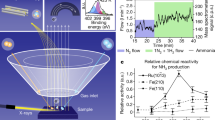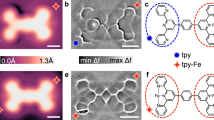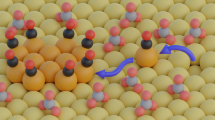Abstract
Direct identification of the active sites of a working catalyst is still a major problem in heterogeneous catalysis. Here we present an operando scanning tunnelling microscopy study, in which insight into the nature of the active sites was obtained for the cobalt-catalysed Fischer–Tropsch synthesis. Experiments were performed on a Co(0001) sample under H2/CO gas mixtures at pressures of up to 950 mbar and a temperature of ~500 K. On the same apparatus, turnover frequencies were measured with a customized gas chromatograph. The density of monoatomic steps of the sample was varied by sputtering. The Fischer–Tropsch activity scaled with step density, from which steps are identified as the active sites of this reaction. The long-standing idea that the activation of the Co catalyst is connected with a roughening of the surface is not confirmed. The known activity function can be explained by pre-existing steps without roughening.
This is a preview of subscription content, access via your institution
Access options
Access Nature and 54 other Nature Portfolio journals
Get Nature+, our best-value online-access subscription
$29.99 / 30 days
cancel any time
Subscribe to this journal
Receive 12 digital issues and online access to articles
$119.00 per year
only $9.92 per issue
Buy this article
- Purchase on Springer Link
- Instant access to full article PDF
Prices may be subject to local taxes which are calculated during checkout







Similar content being viewed by others
Data availability
The data that support the findings of this study are presented within the text and the supporting information or are available from the corresponding author upon reasonable request.
References
Taylor, H. S. & Armstrong, E. S. A theory of the catalytic surface. Proc. R. Soc. Lond. 108, 105–111 (1925).
Boudart, M. Catalysis by Supported Metals. Adv. Catal. 20, 153–166 (1969).
Zambelli, T., Wintterlin, J., Trost, J. & Ertl, G. Identification of the ‘active sites’ of a surface-catalyzed reaction. Science 273, 1688–1690 (1996).
Davis, S. M., Zaera, F. & Somorjai, G. A. Surface structure and temperature dependence of light-alkane skeletal rearrangement reactions catalyzed over platinum single-crystal surfaces. J. Am. Chem. Soc. 104, 7453–7461 (1982).
Hansen, P. L. et al. Atom-resolved imaging of dynamic shape changes in supported copper nanocrystals. Science 295, 2053–2055 (2002).
Vendelbo, S. B. et al. Visualization of oscillatory behaviour of Pt nanoparticles catalysing CO oxidation. Nat. Mater. 13, 884 (2014).
Wang, Z. J., Farra, R., Cao, J., Schlögl, R. & Willinger, M. G. The dynamics of active metal catalysts revealed by in situ electron microscopy. Microsc. Microanal. 22, 4–5 (2016).
Jensen, J. A., Rider, K. B., Salmeron, M. & Somorjai, G. A. High pressure adsorbate structures studied by scanning tunneling microscopy: CO on Pt(111) in equilibrium with the gas phase. Phys. Rev. Lett. 80, 1228–1231 (1998).
Österlund, L. et al. Bridging the pressure gap in surface science at the atomic level: H/Cu(110). Phys. Rev. Lett. 86, 460–463 (2001).
Hendriksen, B. L. M. & Frenken, J. W. M. CO oxidation on Pt(110): scanning tunneling microscopy inside a high-pressure flow reactor. Phys. Rev. Lett. 89, 046101 (2002).
Böcklein, S., Günther, S. & Wintterlin, J. High-pressure scanning tunneling microscopy of a silver surface during catalytic formation of ethylene oxide. Angew. Chem. Int. Ed. 52, 5518–5521 (2013).
Pfisterer, J. H. K., Liang, Y., Schneider, O. & Bandarenka, A. S. Direct instrumental identification of catalytically active surface sites. Nature 549, 74–77 (2017).
Bartholomew, C. H. and Farrauto, R. J. Fundamentals of Industrial Catalytic Processes 2nd edn (Wiley-Interscience, 2006).
Kaiser, P., Pöhlmann, F. & Jess, A. Intrinsic and effective kinetics of cobalt-catalyzed fischer-tropsch synthesis in view of a power-to-liquid process based on renewable energy. Chem. Eng. Technol. 37, 964–972 (2014).
den Breejen, J. P. et al. On the origin of the cobalt particle size effects in Fischer–Tropsch catalysis. J. Am. Chem. Soc. 131, 7197–7203 (2009).
Oukaci, R., Singleton, A. H. & Goodwin, J. G. Comparison of patented Co F–T catalysts using fixed-bed and slurry bubble column reactors. Appl. Catal. A 186, 129–144 (1999).
van Santen, R. A., Markvoort, A. J., Filot, I. A. W., Ghouri, M. M. & Hensen, E. J. M. Mechanism and microkinetics of the Fischer–Tropsch reaction. Phys. Chem. Chem. Phys. 15, 17038–17063 (2013).
Wilson, J. & de Groot, C. Atomic-scale restructuring in high-pressure catalysis. J. Phys. Chem. 99, 7860–7866 (1995).
Geerlings, J. J. C., Zonnevylle, M. C. & de Groot, C. P. M. Studies of the Fischer–Tropsch reaction on Co(0001). Surf. Sci. 241, 302–314 (1991).
Beitel, G. A., de Groot, C. P. M., Oosterbeek, H. & Wilson, J. H. A combined in-situ PM-RAIRS and kinetic study of single-crystal cobalt catalysts under synthesis gas at pressures up to 300 mbar. J. Phys. Chem. B 101, 4035–4043 (1997).
Schulz, H. Selforganization in Fischer–Tropsch synthesis with iron- and cobalt catalysts. Catal. Today 228, 113–122 (2014).
Banerjee, A. et al. Shape and size of cobalt nanoislands formed spontaneously on cobalt terraces during Fischer–Tropsch synthesis. J. Phys. Chem. Lett. 7, 1996–2001 (2016).
Zhang, X. Q., van Santen, R. A. & Hensen, E. J. M. Carbon-induced surface transformations of cobalt. ACS Catal. 5, 596–601 (2015).
Ehrensperger, M. & Wintterlin, J. In situ high-pressure high-temperature scanning tunneling microscopy of a Co(0001) Fischer–Tropsch model catalyst. J. Catal. 319, 274–282 (2014).
Ehrensperger, M. & Wintterlin, J. In situ scanning tunneling microscopy of the poisoning of a Co(0001) Fischer–Tropsch model catalyst by sulfur. J. Catal. 329, 49–56 (2015).
Navarro, V., van Spronsen, M. A. & Frenken, J. W. M. In situ observation of self-assembled hydrocarbon Fischer–Tropsch products on a cobalt catalyst. Nat. Chem. 8, 929–934 (2016).
Rößler, M., Geng, P. & Wintterlin, J. A high-pressure scanning tunneling microscope for studying heterogeneous catalysis. Rev. Sci. Instrum. 76, 023705 (2005).
Oosterbeek, H. Bridging the pressure and material gap in heterogeneous catalysis: cobalt fischer–tropsch catalysts from surface science to industrial application. Phys. Chem. Chem. Phys. 9, 3570–3576 (2007).
Yang, J. et al. Reaction mechanism of CO activation and methane formation on Co Fischer–Tropsch catalyst: a combined DFT, transient, and steady-state kinetic modeling. J. Catal. 308, 37–49 (2013).
Huffman, G. P. et al. In-situ XAFS investigation of K-promoted Co catalysts. J. Catal. 151, 17–25 (1995).
Ernst, B., Bensaddik, A., Hilaire, L., Chaumette, P. & Kiennemann, A. Study on a cobalt silica catalyst during reduction and Fischer–Tropsch reaction: in situ EXAFS compared to XPS and XRD. Catal. Today 39, 329–341 (1998).
Cats, K. H. et al. X-ray nanoscopy of cobalt Fischer–Tropsch catalysts at work. Chem. Commun. 49, 4622–4624 (2013).
Nishizawa, T. & Ishida, K. The Co (cobalt) system. Bull. Alloy Phase Diagr. 4, 387–390 (1983).
Weststrate, C. J., van Helden, P., van de Loosdrecht, J. & Niemantsverdriet, J. W. Elementary steps in Fischer–Tropsch synthesis: CO bond scission, CO oxidation and surface carbiding on Co(0001). Surf. Sci. 648, 60–66 (2016).
Böller, B., Ehrensperger, M. & Wintterlin, J. In situ scanning tunneling microscopy of the dissociation of CO on Co(0001). ACS Catal. 5, 6802–6806 (2015).
Weststrate, C. J. et al. Atomic and polymeric carbon on Co(0001): surface reconstruction, graphene formation, and catalyst poisoning. J. Phys. Chem. C. 116, 11575–11583 (2012).
Gong, X. Q., Raval, R. & Hu, P. CO dissociation and O removal on Co(0001): a density functional theory study. Surf. Sci. 562, 247–256 (2004).
Qi, Y., Yang, J., Chen, D. & Holmen, A. Recent progresses in understanding of Co-based Fischer–Tropsch catalysis by means of transient kinetic studies and theoretical analysis. Catal. Lett. 145, 145–161 (2015).
Hammer, B. & Nørskov, J. K. Theoretical surface science and catalysis—calculations and concepts. Adv. Catal. 45, 71–129 (2000).
Van Santen, R. A. Complementary structure sensitive and insensitive catalytic relationships. Acc. Chem. Res. 42, 57–66 (2009).
Weststrate, C. J. et al. Interaction of hydrogen with flat (0001) and corrugated (11–20) and (10–12) cobalt surfaces: insights from experiment and theory. Catal. Today https://doi.org/10.1016/j.cattod.2019.04.002 (2019).
Pestman, R., Chen, W. & Hensen, E. Insight into the rate-determining step and active sites in the Fischer–Tropsch reaction over cobalt catalysts. ACS Catal. 9, 4189–4195 (2019).
van Helden, P., Ciobîcă, I. M. & Coetzer, R. L. J. The size-dependent site composition of FCC cobalt nanocrystals. Catal. Today 261, 48–59 (2016).
Tsakoumis, N. E. et al. Fischer–Tropsch synthesis: an XAS/XRPD combined in situ study from catalyst activation to deactivation. J. Catal. 291, 138–148 (2012).
Haddad, G. J., Chen, B. & Goodwin, J. J. G. Effect of La3+ promotion of Co/SiO2 on CO hydrogenation. J. Catal. 161, 274–281 (1996).
Ribeiro, F. H., Schach Von Wittenau, A. E., Bartholomew, C. H. & Somorjai, G. A. Reproducibility of turnover rates in heterogeneous metal catalysis: compilation of data and guidelines for data analysis. Catal. Rev. 39, 49–76 (1997).
Bezemer, G. L. et al. Cobalt particle size effects in the Fischer–Tropsch reaction studied with carbon nanofiber supported catalysts. J. Am. Chem. Soc. 128, 3956–3964 (2006).
Inderwildi, O. R., Jenkins, S. J. & King, D. A. Fischer–Tropsch mechanism revisited: alternative pathways for the production of higher hydrocarbons from synthesis gas. J. Phys. Chem. C. 1305–1307 (2008).
Yeh, J. J. & Lindau, I. Atomic subshell photoionization cross sections and asymmetry parameters: 1 ⩽ Z ⩽ 103. Data Nucl. Data Tables 32, 1–155 (1985).
Reilman, R. F., Msezane, A. & Manson, S. T. Relative intensities in photoelectron spectroscopy of atoms and molecules. J. Electron. Spectrosc. Relat. Phenom. 8, 389–394 (1976).
Tanuma, S., Powell, C. J. & Penn, D. R. Calculations of electron inelastic mean free paths. V. Data for 14 organic compounds over the 50–2000 eV range. Surf. Interface Anal. 21, 165–176 (1994).
Author information
Authors and Affiliations
Contributions
B.B. performed the STM, XPS and GC measurements and analysed the data. K.M.D. deployed and tested the GC. B.B. and J.W. wrote the manuscript. J.W. conceived and supervised the project.
Corresponding author
Ethics declarations
Competing interests
The authors declare no competing interests.
Additional information
Publisher’s note Springer Nature remains neutral with regard to jurisdictional claims in published maps and institutional affiliations.
Supplementary Information
Supplementary Information
Supplementary Tables 1 and 2, Supplementary Figs. 1–4 and Supplementary References.
Supplementary Video 1
Time lapse of 18 STM images recorded during a period of 80 min on the same area of the sample. Conditions were a total pressure of 200 mbar syngas, an H2:CO = 2:1 mixture, and a sample temperature of 493 K. The first frame was taken 3.5 h after heating the sample to 493 K. Images 3 and 8 are displayed in Fig. 3(a) and (b) of the main text. The video was corrected for a small thermal drift. One can see that the step positions fluctuate, demonstrating the high mobility of cobalt atoms under the reaction conditions (200 × 200 nm2, Vt = −0.5 V, It = 0.7 nA).
Supplementary Video 2
Time lapse of 18 STM images recorded during a period of 25 min. The data were taken under 950 mbar syngas (H2:CO = 2:1) and at a sample temperature of 493 K. The first frame was taken 3 h after heating the sample to 493 K. The fringes of the steps are caused by cobalt atoms diffusing along the steps or exchanging between steps and terraces at a faster rate than the rate of the scan lines (7 Hz) (these effects are still slow compared to the 10−13 to 10−12 s time scale of elementary chemical processes, such as the dissociation of a CO molecule, which thus ‘see’ a static step) (18× 18 nm2, Vt = −0.5 V, It = 0.7 nA).
Supplementary Video 3
Time lapse of 19 STM images recorded during a period of 2.5 h. The data were recorded on the sputtered Co(0001) sample in 950 mbar syngas (H2:CO = 2:1) and at a sample temperature of 493 K. The first frame was taken 80 min after heating the sample to 493 K. The video shows that several of the topmost terraces shrink and at the same time that lower cobalt layers become partially or completely filled (90 × 90 nm2, Vt = 0.05 V, It = 0.7 nA).
Supplementary Video 4
Time lapse of the 19 STM images from Supplementary Video 3 showing the differences between successive images. Image no. 5 served as a reference image and was subtracted from all images to highlight the morphological changes (images no. 1 to no. 4 were not suitable as references because in this phase of the experiment the thermal drift was still too strong). By this subtraction, areas in images no. 6 to no. 19 where Co terraces grow by adding Co atoms to the steps appear bright, and areas where Co atoms are removed from the steps appear dark. Accordingly, image no. 5 itself appears homogeneously grey, and in images no. 1 to nos. 4 the bright/dark contrast of growing and shrinking terraces is inverted.
Rights and permissions
About this article
Cite this article
Böller, B., Durner, K.M. & Wintterlin, J. The active sites of a working Fischer–Tropsch catalyst revealed by operando scanning tunnelling microscopy. Nat Catal 2, 1027–1034 (2019). https://doi.org/10.1038/s41929-019-0360-1
Received:
Accepted:
Published:
Issue Date:
DOI: https://doi.org/10.1038/s41929-019-0360-1
This article is cited by
-
Complementary probes for the electrochemical interface
Nature Reviews Chemistry (2024)
-
Unraveling surface structures of gallium promoted transition metal catalysts in CO2 hydrogenation
Nature Communications (2023)
-
The concept of active site in heterogeneous catalysis
Nature Reviews Chemistry (2022)
-
Automated calculation and convergence of defect transport tensors
npj Computational Materials (2020)
-
Mechanistic insight into carbon-carbon bond formation on cobalt under simulated Fischer-Tropsch synthesis conditions
Nature Communications (2020)



